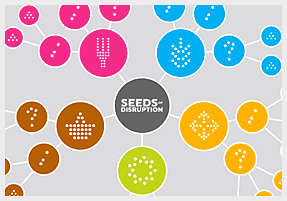Seeds of Disruption
How technology is remaking the future of food
Artifacts from the Future
Tangible, Concrete, Experiential
Imagine that you could take an archaeologist’s expedition to the future to collect objects and fragments of text or photos to understand what daily life will be like in 10, 20, or 50 years. Artifacts from the Future give us this tangible experience of the future. They make the details of a scenario concrete, helping us to understand, almost first-hand, what it will be like to live in a particular future.
Artifacts from the Future may take dozens of forms, from the familiar bumper sticker to labels for the food we eat to future credit card statements. They can be 3D objects, like product containers, or videos that give us the physical experience of wearing augmented reality glasses as we walk down a street. These familiar objects of everyday life help us translate today's trends and signals into intimate future experiences—and these experiences, in turn, increase our capacity to draw on our intuitive intelligence when making decisions about the future.
New Metrics at the Butcher
From SUSTAINABILITY: Sourcing Mindfulness
WHAT:
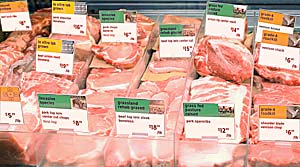 As you stare at the butcher’s case, you can’t help but think about how much you’d really like that grass-fed, pasture-raised beef, but you know your partner isn’t having it—not nearly sustainable enough. You’d settle for lab-grown, but that just isn’t natural enough for him. You can’t, for the life of you, understand how it’s somehow more natural to eat something that got hit by a bus, but road-kill meat is his preference. And with the upscale, eco-conscious crowd at West Oakland Community Market, it’s always in demand.
As you stare at the butcher’s case, you can’t help but think about how much you’d really like that grass-fed, pasture-raised beef, but you know your partner isn’t having it—not nearly sustainable enough. You’d settle for lab-grown, but that just isn’t natural enough for him. You can’t, for the life of you, understand how it’s somehow more natural to eat something that got hit by a bus, but road-kill meat is his preference. And with the upscale, eco-conscious crowd at West Oakland Community Market, it’s always in demand.
SO WHAT:
Concepts such as carbon footprints and food miles, humane treatment of animals, ecosystems management, and waste reduction are all big concerns for eaters today. However, as our ability to take all of these to the extreme increases, we’ll see the tradeoffs and choices become more dramatic, creating diverse new sustainability standards. While eating road-kill and invasive species are, today, fringe behaviors, in a decade, they could become commonplace.
Virtual Reality In-flight Dining
From SATISFACTION: Personalized Cravings
WHAT:
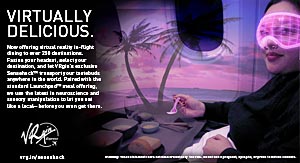 You’ve been making that six-hour flight from Los Angeles to New York every month for a year and you hit peak-peanut consumption long ago. You just got an email that you’re finally eligible for a free in-flight meal upgrade to the virtual reality dining service for tomorrow’s flight. You used to scoff at people wearing them, but after reading a few reviews online, it sounds like you’re actually in for a treat. A few people say that the virtual seared foie gras is better than any they’ve had in reality.
You’ve been making that six-hour flight from Los Angeles to New York every month for a year and you hit peak-peanut consumption long ago. You just got an email that you’re finally eligible for a free in-flight meal upgrade to the virtual reality dining service for tomorrow’s flight. You used to scoff at people wearing them, but after reading a few reviews online, it sounds like you’re actually in for a treat. A few people say that the virtual seared foie gras is better than any they’ve had in reality.
SO WHAT:
The ability to directly and precisely manipulate the human senses will open a new frontier for creating food experiences. Initial attempts to rewire taste will likely be around curbing the hardwired drives for fats and sugars to improve health. However, as we develop a more nuanced understanding of both the chemical and psychological components that make up how we perceive food, people will start hacking the senses for many different goals—maximizing bliss, recreating nostalgic meal experiences, or making healthy, but bland, foods more enjoyable.
Freshness: Quantifying Peak Flavors
From FRESHNESS: Quantifying Peak Flavors
WHAT:
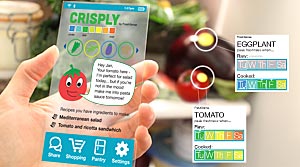 Your fridge always used to have a few of those notorious tomatoes—the ones whose skin is just starting to shrivel. You knew you should eat them, but always passed them up for fresher looking alternatives until it was too late. But now you can’t ignore them! It is that tomato’s dying wish to be consumed at peak freshness, and Crisply won’t let you forget it. So far it’s working! You’re throwing out less produce while also branching out to try new recipes.
Your fridge always used to have a few of those notorious tomatoes—the ones whose skin is just starting to shrivel. You knew you should eat them, but always passed them up for fresher looking alternatives until it was too late. But now you can’t ignore them! It is that tomato’s dying wish to be consumed at peak freshness, and Crisply won’t let you forget it. So far it’s working! You’re throwing out less produce while also branching out to try new recipes.
SO WHAT:
Freshness-sensing packaging and produce stickers will provide more precise expiry information than traditional “best by” labels. However, this information has the potential to overload consumers with metrics and considerations that don’t help them make decisions. To truly make this information actionable, people will need solutions that make interacting with the new data intuitive and enjoyable.
Autonomous Vehicle Shopping Systems
From CONVENIENCE: Rethinking Shopping
WHAT:
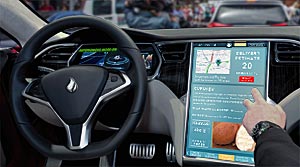 You’ve been in stop-and-go traffic for almost an hour now. You normally use this time in the passenger seat of your self-driving car to finish up work emails, but all those are tended to, so you decide do some grocery shopping and surprise your kids with their favorite Amazonian fruits tonight. Your daughter loves cupuaçu, and you’re excited by the new “delay delivery” feature, which analyzes current traffic and makes sure that your purchase is routed to arrive home at the same time you do, so you can be the one to hand it to her directly.
You’ve been in stop-and-go traffic for almost an hour now. You normally use this time in the passenger seat of your self-driving car to finish up work emails, but all those are tended to, so you decide do some grocery shopping and surprise your kids with their favorite Amazonian fruits tonight. Your daughter loves cupuaçu, and you’re excited by the new “delay delivery” feature, which analyzes current traffic and makes sure that your purchase is routed to arrive home at the same time you do, so you can be the one to hand it to her directly.
SO WHAT:
In a decade, new technologies of coordination will make it possible to order almost anything from anywhere and have it arrive at a designated place and time. New platforms and smart logistics systems are poised to disrupt the largely untapped market for fresh food delivery. As the cold chain expands in places such as Brazil or China, rapidly urbanizing areas might leapfrog the less efficient supermarket model in favor of streamlined food delivery systems.
